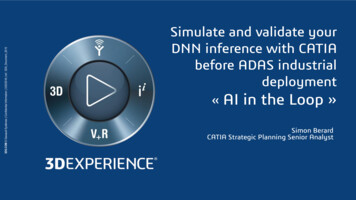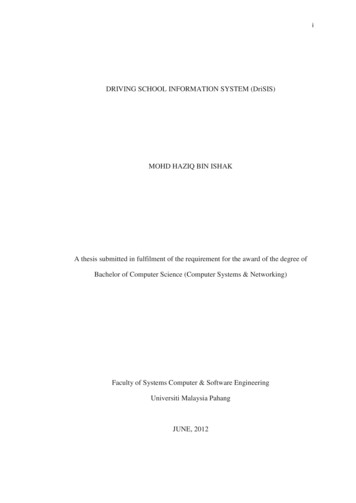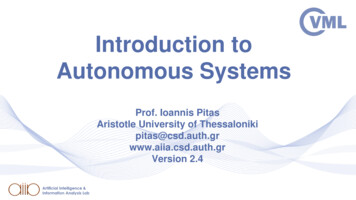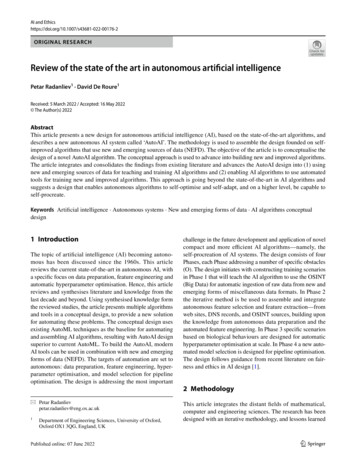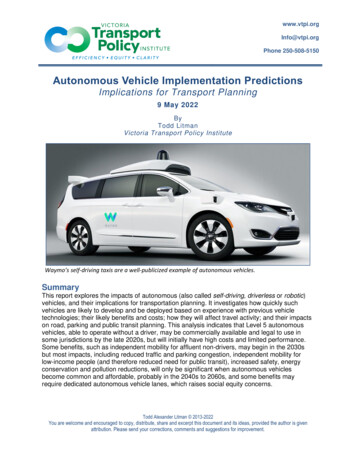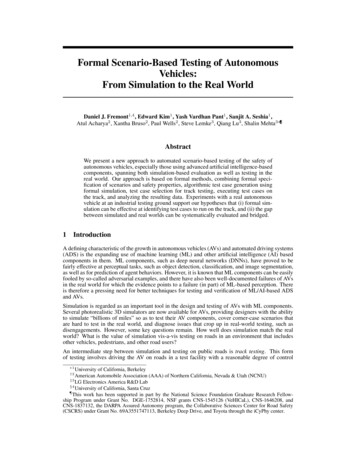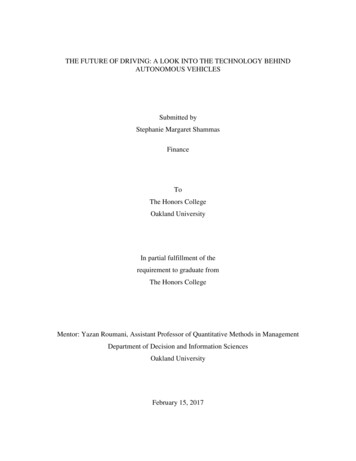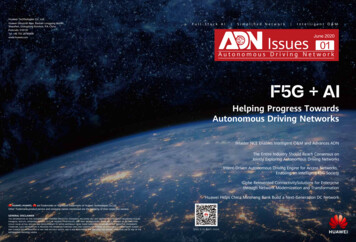
Transcription
Full-StackAI SimplifiedNetwork IntelligentIssuesO&MJune 2020Autonomous Driving NetworkHelping Progress TowardsAutonomous Driving NetworksiMaster NCE Enables Intelligent O&M and Advances ADNThe Entire Industry Should Reach Consensus onJointly Exploring Autonomous Driving NetworksIntent-Driven Autonomous Driving Engine for Access Networks,Enabling an Intelligent F5G SocietyGlobe Reinvented ConnectivitySolutions for Enterprisethrough Network Modernization and TransformationHuawei Helps China Minsheng Bank Build a Next-Generation DC NetworkScan it to learn more
Autonomous Driving Network Special Issues Issue 1COVER ARTICLEMoving Towards the AutonomousDriving Network FeaturingMan-Machine CollaborationJessie LiuHuawei ADN Chief Marketing OfficerIn the future, a smart society with everythingsensing, connected, and intelligent willemerge. Currently, the digital economy hasbecome the world's most important neweconomic form, with the global economyfacing great challenges and pressure in 2020.Driven by digital technology innovation, the"new infrastructure" industry will show stronggrowth momentum and innovative vitality.During the global battle against COVID-19,carriers' communications networks, as thefoundation of online activities, are undertakinga large number of key tasks, includingtelecommuting, online education, and onlineshopping. This sudden pandemic isaccelerating the digitalization of the entireindustry. Both mobile and fixed networktechnologies are constantly evolving to adaptto the intelligent era of Internet of Everything.The advent of the 5G and F5G era will bettersupport the vigorous development and wideapplication of digital intelligent applications,and promote the rapid development of theglobal digital economy.While embracing new opportunities, thetelecom industry is facing the followingchallenges. The equipment-centric networkAutonomous Driving NetworkSpecial IssuesIssue 1June 2020construction mode and manual O&M mode of thelast decade are unsustainable. According to a reportby OVUM, as networks grow in scale and servicesbecome more complex, OPEX rapidly increases,profitabilit y decreases, and the structuralcontradiction becomes increasingly prominent.N e t wo r k co m p l e x i t y i s a l s o i n c re a s i n g d u e t oco-existing 2G, 3G, 4G, and 5G networks. In addition,business innovation is slow, and it takes as long as6–12 months to respond to new digital services andapplications.We firmly believe that the telecom industry shouldf u l l y, s c i e n t i fi c a l l y, a n d e ff e c t i v e l y u s e n e wtechnologies such as AI, big data, and automation,and leverage data and knowledge to build anautonomous network that features automation,self-healing, and self-optimization. On this network,services can be agilely enabled, optimal experienceenables value monetization, and intelligent O&Machieves maximum resource and energy utilization.Over the last two years, through active explorationand practice by all industry parties, we have seen thatADN has abundant application scenarios and businessvalues. AI is being introduced to cloud services, localnetworks, and devices at different layers, reshapingthe telecom network's intelligence core, enablingnet works to progress towards ADNs featuringman-machine collaboration, and further promotingthe intelligent upgrade and sustainable developmentof the industry.02
CONTENTSAutonomous Driving Network Special Issues Issue 1EDITOR IN CHIEFDriving Network Featuringan-MachineCollaborationSPECIAL REPORT26 ADN Enables High-QualityMonetization of All-Optical NetworksHelping optical transport networks achieve the "anytime response,on-demand transformation, and ultimate connection experience"required by emerging services in the intelligent era, will become the keyfor the evolution of optical transport networks into all-optical productionnetworks, as well as the transformation from a traditional cost center toa new value center.HOT FOCUS49 Globe Reinvented Connectivity Solutions forEnterprise through Network Modernization andTransformationOne of the key components of building a digital nation is building a digital enterprise, and our goal is toKnowledge and data are being leveraged to drive architecture, process, andleverage on our data business as well as our IT-enabled services to help businesses perform more thantalent transformation, enabling the DevOps capabilities of carriers' servicewhat is usual. By being passionate as our clients are with their business, we will be able to achievemodel production, as well as O&M process design and orchestration. Thisconsistent growth.reshapes the telecom industry's core and enables networks to progresstowards ADNs featuring man-machine collaboration, promoting theintelligent upgrade and sustainable development of the industry.COVER ARTICLE06 iMaster NCE Enables IntelligentO&M and Advances ADN32 Intent-Driven AutonomousDriving Engine for Access Networks,Enabling an Intelligent F5G Societyinformation in depth. The real-time awareness and scientific analysis resultshelp carriers to construct, provision, maintain, and operate services, achievingautomation and intelligence during the entire process.networks.INDUSTRY TREND20 The Entire Industry ShouldReach Consensus on Jointly ExploringAutonomous Driving NetworksThe rapid growth of the 5G era has seen network O&M face growing challenges. This era has witnessed ashift from cost-reducing O&M to O&M that is capable of producing benefits for carriers, driving the trafficmonetization of network O&M.59 Huawei Helps China Minsheng Bank Build aNext-Generation DC NetworkDigital transformation cannot be achieved without the innovation and construction of the data center(DC) IT infrastructure, as the infrastructure is the foundation of all digital economies and essential to thefirst system in the industry to integrate Manager, Controller, Analyzer, and AI,implements centralized management, control, and analysis of global54 O&M Transformation: from Manual to AIBig data and AI technologies are utilized to analyze and process obtainediMaster NCE is an intelligent management and control unit for FBB. As theiMaster NCE effectively connects physical networks with business intents and41 Data Center Network AutonomousDriving Engine, Accelerating DigitalTransformation of EnterprisesAs data center (DC) networks carry all the data and services of enterprises,network scale and complexity have increased to a level beyond themanagement capabilities of humans. Therefore, enterprises need a newsystem that combines advanced technologies, such as machine learning,machine inference, and automation, to meet business needs, simplifyoperations, intelligently assist human decisions, and ultimately make DCnetworks highly autonomous.provisioning and guarantee of agile and innovative services. As cloud computing and virtualizationtechnologies develop rapidly, new architectures and technologies are being introduced to theinfrastructure.63 CAT Telecom Thailand: Private Line Market Leaderwith High-Quality OTN NetworksCAT Telecom is determined to build a nation-wide flattened network using Huawei's end-to-endOTN iMaster NCE Solution. It aims to provide differentiated high-quality services for the digitaltransformation of enterprise customers in Thailand.68 China Mobile Zhejiang Launches Intent-Driven 5GThe telecom ADN revolutionizes the existing network industry. It willTransport Networkbring profound changes to the existing organizations, processes, supportFacing challenges posed to the transport network by the development of 5G services, China Mobilesystems, network construction, and procurement methods of carriers.Zhejiang and Huawei established a 5G transport innovation project team in 2016. The team continuouslyTherefore, all industry parties need to participate in the transformation,invested in the exploration and research of 5G transport networks, achieving remarkable results. In 2018,and collaborate to achieve win-win development.the largest 5G trial transport network in China was built.03CO NTE NTSCONTENTS02 Moving Towards the AutonomousAutonomous Driving Network Special Issues Issue 104
Autonomous Driving Network Special Issues Issue 1COVER ARTICLEiMaster NCE Enables IntelligentO&M and Advances ADNBy Lu Haiou, director of NCE Product DeptLu HaiouiMaster NCE Enables Intelligent O&M and Advances ADNDirector of NCE Product DeptThe global telecom industry is experiencingrapid technological innovations brought by theInternet of Things (IoT), especially in the 5Gand cloud era. An increasing number of newservices, such as virtual reality (VR), augmentedrealit y (AR), 4K live streaming, remoteeducation, and unmanned driving, are emergingand being upgraded. As a result, there is anexplosive growth in network traffic, makingt e l e c o m n e t w o r k s i n c re a s i n g l y c o m p l e x .According to Gartner's report, the biggestchallenge for carriers involves implementingnetwork automation and intelligent O&M toimprove service agility, ensure optimal userexperience, and reduce OPEX.06
Autonomous Driving Network Special Issues Issue 1iMaster NCE Enables Intelligent O&M and Advances ADNiMaster NCE: Intelligent Management and Control Unit for FBB07Cloud AI Telecom AIOpsiMaster NAIEKnowledgeO&M designData Model Developmentasset & processTrainingdataManager ControllerAnalyzeriMaster MAEAIalgorithmsManager ControllerAnalyzeriMaster NCENetwork AI Real-time closed loopMBBFBBSimplified networkServiceorchestrationIntelligent O&MiMaster AUTINAll-IntelligenceThe telecom industry has been exploringdigitalization, automation, and intelligence.Initially, customers hoped to use SDN, NFV,and cloud technologies to improve serviceand network agility as well as reduce O&Mcomplexity and costs. Progress has beenmade in SDN with regard to net workautomation in scenarios such as datacenter (DC ), WAN opt imizat ion, andSD-WAN; whereas NFV is equipped withimproved resource utilization in vIMS,vEPC, and vCPE scenarios. In addition,DevOps processes and continuousintegration and delivery tools improveproduct development efficiency. In general,network automation still lags behind interms of technological development — itcannot address the complexity inmanaging and operating old and newnetworks, or performance issues regardinglarge-scale application. A widespreadchallenge in the industry involvesdiscovering an appropriate method toimprove network O&M efficiency.The autonomous driving network (ADN)was developed under this context. It takessimplified networks and simplified O&M asits core philosophy, and aims to drive thetelecom industry from automation tointelligence by employing variousintelligent technologies and leveragingNE AI Real-time awarenessFigure 1: Architecture of the ADN solutionintegration advantages. Products are planned,designed, and developed according to this philosophy.ADN adopts a three-layer open architecture, whichintroduces AI into edges, networks, and clouds. Theproduct components include the cloud network AI unitiMaster NAIE, cross-domain intelligent O&M unitiMaster AUTIN, network intelligent management andcontrol units iMaster MAE and iMaster NCE, as well asnetwork infrastructure with built-in AI. The ADNsolution includes fixed broadband (FBB) and mobilebroadband (MBB) sub-solutions that enable carriers toincrease quality, revenue, and efficiency while loweringcosts.iMaster NCE is an intelligent management andcontrol unit for FBB. As the first system in theindustr y to integrate Manager, Controller,Analyzer, and AI, iMaster NCE effectively connectsphysical networks with business intents andimplements centralized management, control, andanalysis of global networks. It enables resourcecloudification, full-lifecycle automation, and dataanalytics-driven intelligent closed loops accordingto business and service intents, as well as providesopen network APIs for rapid integration with ITsystems. Mainly utilized in carrier networks, DCs,enterprise campuses, and enterprise private lines,iMaster NCE creates simple, smart, open, andsecure networks while also accelerating servicetransformation and innovation for carriers andenterprises.ITPlanningOSSApplicationiMaster NCE OfferingNCE-IPOptimizationConstruction MaintenanceNCE-TAnalyzerOpen NBIAPIorchestrationSouthboundintegrationManager ControllerNCE-SuperCOVER ARTICLENCE-FANTransportnetworkProduct Design Philosophy:Single-Domain AutonomyAs telecom services become intelligent and agile,telecom networks increasingly integrate withoperation systems. Based on servicecharacterist ics, net work technologies, andmaintenance patterns, carriers divide basicnetworks and operation systems into differentcombinations, with each one being referred to asan autonomous domain. Autonomous domainscan independently complete entire processes(covering data collection, analysis, control, andoptimization) and provide agilenetwork-as-a-service (NaaS) for the outsideworld. Conventional network operation systemsinvolve complex processes and collaborationamong dozens or even hundreds of systems,which leads to complex and time-consumingservice provisioning and fault diagnosis. Operationsystems can be simplified by integrating therelated net work management , control, andanalysis systems so that they can evolve fromautomation to autonomy in OVER ARTICLEDatanetworkFigure 2: Architecture of iMaster NCEManager, Controller, and Analyzer in iMaster NCEcan be flexibly deployed in different scenarios,and single-domain NCE can evolve tomulti-domain NCE.Manager Controller Analyzer:Scenario-Centered Closed-Loop AutonomyiMaster NCE combines conventional elementmanagement systems (EMSs), SDN controllers,and performance and traffic analysis systems. Toensure that data can be shared among Manager,Controller, and Analyzer, it uniformly modelsnetwork, service, and user experience data. Inaddition, iMaster NCE provides a unified servicemodel and real-time network status awareness,enabling automated service provisioning andclosed-loop service optimization.Fo r e x a m p l e , i M a s t e r N C E i s d e d i c a t e d t oimplementing automation and closed-loopa u t o n o m y t h ro u g h o u t t h e l i fe c y c l e o f D Cnetworks. During the planning, design,08
COVER ARTICLEinstallation, and deployment phases, typical networks are designed automatically, one-click deploymentis supported, and basic network construction or capacity expansion can be completed within 1 hour.During the service provisioning and change phases, no network configuration errors are made andservices can be automatically rolled out within a few minutes. During the monitoring and O&M phase,typical faults can be automatically detected, diagnosed, and rectified within minutes, ensuring thatservices run stably.AI: Enhanced Closed-Loop Autonomy in Complex ScenariosTelecom network services are complex, uncertain,and subject to changes. Specifically, diversifiedservices pose various requirements on networks,and network traffic fluctuates while service pathschange during different time periods. If a networkfault occurs, troubleshooting is driven by customercomplaints or network alarms. Experts needoperations support systems (OSSs), EMSs, or toolsduring manual analysis, decision-making, andfault closure. In complex scenarios, this methodcannot be used to quickly rectify faults or ensureservice experience.As big data and AI technologies mature, thetelecom industry is starting to introduce AItheories and engineering algorithms into complexand uncertain scenarios, including fast faultdiagnosis and precise traffic prediction, to enhanceclosed-loop autonomy capabilities. To digitalizeexpert experience, iMaster NCE injects a broadrange of management rules, troubleshootingmethods, and additional knowledge into ac e n t ra l i z e d k n o w l e d g e b a s e t h a t c a n b eunderstood and used by computers. It alsoexplores the industry's mainstream AI algorithmsand matches the optimal ones with specificscenarios to provide proactive analysis andprediction.COVER ARTICLEAutonomous Driving Network Special Issues Issue 1iMaster NCE Enables Intelligent O&M and Advances ADNOpen Programmability:Simplified O&M andOpen EcosystemTelecom network O&M is complex.One reason for this is that telecomnetworks usually consist of devicesfrom multiple vendors, creatingdifficulties in E2E service provisioningand maintenance. Another reason isthat the networking and technicalsolutions for different networks arenot uniform, leading to differentO&M processes and approaches aswell as low reusability.By offering an abundant set of APIsor scenario-specific O&M apps,iMaster NCE simplifies network O&M,opens network service capabilities,and enables third-party ecosystems.An API proxy service enables iMasterNCE to offer a unified API access andauthentication mechanism as well asnorthbound and southbound networkprogrammability. Additionally, iMasterNCE supports orchestration of atomicAPIs (as scenario-specific APIs) andO&M automation (based onworkflows), and its model-baseddevelopment (MBD) framework canadapt to third-party devices to deliverfast , programmable third-part ynetwork integration capabilities.4 Engines in the Core of theProduct ArchitectureThe architecture of iMaster NCE can be summarized as onecloud platform, one digital twin network map, four engines,and one API gateway. Based on a unified cloud platform inmicroservice-oriented architecture, iMaster NCE is equippedwith cloud architecture capabilities such as auto-scaling andload balancing. The digital twin network map is responsiblefor network data governance and digital mapping of physicalnetworks to support upper-layer system applications. Fourengines (automation, intent, analytics, and intelligenceengines) collaborate to implement network automation andintelligence, and iMaster NCE's capabilities at each layer canbe opened through APIs to quickly integrate with peripheralsystems.AI training centerDesign StudioThird-party appOpen API nceIntent engineIntelligence engineAutomation engineAnalytics engineWorkflowPipelineSND/SSPCloud gure 3: Product architecture with four engines as the core0910
COVER ARTICLEAutonomous Driving Network Special Issues Issue 1iMaster NCE Enables Intelligent O&M and Advances ADNAutomation Engine:Automated Network ServicesThe automation engine integrates two importantcomponents: Manager and Controller. It providesfunctions such as automatic NE management,network service management, network pathcomputation, and network optimization. Whenusers deploy services on a network, this engineautomatically computes and delivers service paths.In addition, Controller can centrally schedule globalresources to meet SLA requirements and improveresource utilization. In MBD mode, the automationengine quickly integrates and manages third-partyNEs as well as expands network serviceautomation capabilities. It opens NE- andnet work-layer capabilities to support quickintegration with third-party systems and networks.Intent Engine:Deep Automation in Complex ScenariosIntents refer to users' expectations for networkand service status. In this regard, the intent engineenables networks and services to run based onusers' intents. The intent engine of iMaster NCEcan convert simple user language to complexnetwork models and language, automaticallygenerate call plans for services in each domain,and break down complex tasks. For example, toprovision private line services across multiplen e t w o r k d o m a i n s t h a t u s e d i ff e r e n t p i p etechnologies (such as L3VPN or PWE3), users onlyneed to specify the physical locations of thesource and sink sites as well as bandwidthre q u i re m e n t s . T h e i n t e n t e n g i n e c a n t h e nautomatically select the optimal network path,optimal network resources, designated pipetechnology, and appropriate QoS profile tocomplete service provisioning efficiently.The intent engine also supports automatic closureof intents. This involves users predefining theexpected status (such as SLAs) of scenario-specifict a s k s , a s w e l l a s c o r re c t i v e m e a s u re s a n dimplementation policies when the status does notmeet expectations. If the intent engine discoversthat the actual status and expected status areinconsistent, it automatically takes the predefinedmeasure (for example, it recomputes paths oradjusts bandwidth) to maintain networks orservices in the expected status, thereby achievingautonomous network O&M.5 Key CapabilitiesCOVER ARTICLEWeb UIIn terms of product design, development, andverification, iMaster NCE provides a series of keyc a p a b i l i t i e s , s u c h a s s y s t e m r e l i a b i l i t y,multi- dimensional data visualization, faultdiagnosis and recovery in minutes, closed-loopautomation, and open programmability, enablingintelligent O&M and approaching ADN on FBBnetworks.Analytics Engine and Intelligence Engine:Proactive Analysis and ForecastMulti-Dimensional Reliability Technologies,The analytics engine mainly provides the datacollection, storage, and analysis functions. Byintroducing the Telemetry protocol, the analyticsengine collects network and service KPIs inseconds, detects network and service status in realtime, processes and stores network data, extractsdata characteristics, and classifies raw data. Theresults are used as input for the intelligenceengine, which in turn uses machine learning andAI technologies and algorithms to conductinference on the data and provide analysis results.The intelligence engine also verifies and evaluatesthe advantages and disadvantages of AI models,and continuously optimizes the models throughlocal training to increase analysis accuracy.In the future, network data will be large in scale,multi-dimensional, and of a high frequency;therefore, it will be difficult for humans toanalyze, summarize, and evaluate data. Toovercome this challenge, the analytics andintelligence engines of iMaster NCE quickly extractkey information and provide guidance andsuggestions, enabling users to proactively forecastand prevent faults.iMaster NCE uses the local redundancy and remotedisaster recovery (DR) mechanisms to ensure highsystem reliability. The local system supportshierarchical redundancy protection, including 1 1protection for hardware, master/slave protectionfor databases, cluster protection for the softwareplatform, active/standby or cluster protection forapps, and active/standby protection for clientaccess. When a single object is faulty, the localsystem automatically switches to its standbycounterpart within 1 minute to quickly recoverservices.Client accesslayer1Floating IP soleRouteagentAPPMicroService1Keeping the System e1APPMicroService2DBProxyDBProxyVMVMData layer e 4: Local redundancy mechanismDR protection is available between primary and secondary sites, and it relies on database replication. TheDR service is located at the application layer (independent of hardware or virtualization platforms), and itachieves fast fault detection and automatic switchover between the primary and secondary sites. If theprimary site fails, the secondary site can take over services in less than 15 minutes.Third siteArbitrationArbitration linkPrimary siteDR HFSArbitration linkHeartbeatSynchronizeSynchronizeSynchronizeNCE DRDR serviceSecondary Figure 5: Remote DR mechanism1112
COVER ARTICLEAutonomous Driving Network Special Issues Issue 1iMaster NCE Enables Intelligent O&M and Advances ADNDigital Twin Network Map,a main monitor for network driving. This mapVisualizing Multi-dimensional Data for ADNcombines multi-dimension information fromTopology is frequently used as an O&M entrance.Conventional EMSs use topology as a visualizationmethod, which combin es with basic alarminformation and status to help monitoringpersonnel understand networks. iMaster NCEdifferent applications and environments into onemain topology based on scenarios, therebyFault detection3,000,000 (every day)Mass alarmsoffering unified management and O&M of allexperience to network administrators.AlarmBoard �fault)builds a digital twin network map that aims to beKPIIncremental Rendering by DataOverlayLabel addedConfigurationKnowledgeAlgorithmRoot cause(minimum unit for troubleshooting)Fault visualizationFault tree(expert experience)Faultpropagation diagram(AI knowledge graph)Accurate site visit & repair(hardware, line,and other faults)Auto rectification & closure(software, performance,and other faults)Figure 7: Framework of the "Fault 1-3-5" serviceIncremental Rendering by DataOverlayAttachment addedLabel addedDataOverlay3(Name,Node)Label addedNE6 addedNE210.10.10.2DataOverlay2(Service Path)DataOverlay1(Alarm)NE2NE1TopologyFault rectificationOne fault, one ticket300 (every day)Line faultAIinferenceresources as well as one-stop operat ionFault diagnosisCOVER ARTICLENE310.10.10.4BGP RouterID:#1244566 NE110.10.10.1BGP RouterID:#123645NE5NE4Topology SkeletonWith DataOverlaysNE6 addedNE5NE3NE4TopologySkeletonTime10:00 11:00 12:00 13:00 14:00 15:00 16:00 17:00 18:00Figure 6: Digital twin network mapBy cont inuously collect ing and storing NEinventory data, service configuration data,performance data, alarms, and logs, Manager andController digitally map the physical network tothe digital twin network map. Based on models,the digital twin module automatically generates anetwork topology and intelligently restores thephy sical net work topology, enabling O&Mpersonnel to quickly recognize network andd e v i c e c h a ra c t e r i s t i c s a n d i m p r o v e O & Mefficiency. At every moment, multi-dimensionalinformation is saved as snapshots to recordcurrent and historical network status. Historicalstatus can be replayed on demand, and snapshotsat different time points can be compared tointuitively display multi-dimensional networktrends.AI-Powered "Fault 1-3-5" Service, Achieving L3 ADN on DC NetworksNetwork autonomy is the ultimate goal of ADN. To achieve this, humans need to gradually withdrawfrom participating in network O&M. iMaster NCE provides a "Fault 1-3-5" service, which refers to faultdetection in 1 minute, diagnosis in 3 minutes, and rectification in 5 minutes. It is the foundation forreducing manual O&M operations and gradually achieving ADN.13Incorporating Huawei's exert experience, whichfault, one ticket." On Henan Mobile's 5G transporthas been accumulated over the last 30 years, thenetwork, the intelligent alarm service diagnoses"Fault 1-3-5" service further develops new faultapproximately 200,000 alarms as 400 faults daily,analysis rules through continuous fault modelwith over 90% of faults being matched to tickets.training. With the help of AI and knowledgeiMaster NCE also applies "Fault 1-3-5" to DCinference, it can quickly identify the root causes ofnetworks. Based on technologies such as real-timefaults, judge network exceptions, forecast networkcollection with Telemetry, network health check,risks, and recover services manually orknowledge graph optimization, and intent-basedautomatically based on intents.intelligent decision, iMaster NCE can proactivelyFault 1-3-5 is the foundation of intelligent alarmdetect 80% of DC network faults within 1 minute,management in iMaster NCE, and it significantlyidentify the root causes of 75 types of faultsreduces the number of alarms through grouping,within 3 minutes, and rectify typical faults withinclassification, and noise reduction, as well as5 minutes due to continuous learning, training,makes intelligent recommendation possibleand optimization. In this way, DC networks arethrough accurate root cause analysis (RCA). Intaking the lead in achieving L3 ADN, that is,collaboration with customer OSSs, it ensures "oneconditional autonomous driving.14
COVER ARTICLEIntent-Driven Closed-Loop Automationevaluation. Users can intervene and select actionsIntent-based network autonomy requires constantintent assurance, that is, continuous serviceprovisioning. Intent-driven closed-loop automationimplements autonomous management of theentire service lifecycle.or let the system take actions automatically. If noECA policy has been defined, users can select theclosed-loop policy provided by the system toautomatically re-allocate network resources andrestore services.For example, to balance traffic on a DC network,users first define service intents for balancingIntent enginetraffic on leaf nodes. Based on the intents,Intentcatalog ECA n timeMakes decisionsbased on kes actionClosed-loopanalysisIntentdecisionmonitoring tasks are automatically created anddelivered to the intelligent analysis module, whichcollects and analyzes traffic and other KPIs on eachleaf node in real time. If the traffic on a leaf nodeexceeds the preset threshold, an event will bereported to the decision module, which thenMonitorseventsIntent statusmonitoringdecides (based on initial service intents) that someVMs need to be migrated from that node toalternative idle leaf nodes. After the decisionpasses simulation verification, iMaster NCEautomat ically delivers ser vice and net workNetworkoperationsAutomation engineNetworkmonitoringResourcestatusAnalytics engineconfigurations to keep traffic well balanced amongleaf nodes.COVER ARTICLEAutonomous Driving Network Special Issues Issue 1iMaster NCE Enables Intelligent O&M and Advances ADNDesign Studio, Building a Secure andEasy-to-Use Network Openness PlatformCurrently, AOC hashelped China UnicomGuangdong develop afunction to automaticallyactivate multi-vendor IPRAN devices in 5Gtran
NCE-WAN IT Access network Transport network Data network OSS Application Planning Construction Maintenance Optimization Open NBI API orchestration Southbound integration Analyzer Manager Controller Manager Controller Analyzer integration advantages. Products are planned, designed, and developed according to this philosophy.

